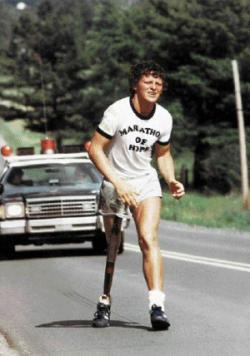Osteosarcoma epidemiology and demographics: Difference between revisions
No edit summary |
No edit summary |
||
| Line 6: | Line 6: | ||
[[Image:Terry fox running.jpg|thumb|200px|Terry Fox (1958-1981) began a run across Canada to raise money for cancer research. He developed osteosarcoma as a teenager and had a leg amputated. Today the Terry Fox Run continues to raise money for cancer research. Through the money raised by the fundraising runs major improvements were made in the treatment of the cancer. Today amputations are rare.]] | [[Image:Terry fox running.jpg|thumb|200px|Terry Fox (1958-1981) began a run across Canada to raise money for cancer research. He developed osteosarcoma as a teenager and had a leg amputated. Today the Terry Fox Run continues to raise money for cancer research. Through the money raised by the fundraising runs major improvements were made in the treatment of the cancer. Today amputations are rare.]] | ||
Osteosarcoma is the 6<sup>th</sup> leading [[cancer]] in children under age 15. Osteosarcoma affects 400 children under age 20 and 500 adults (most between the ages of 15-30) every year in the USA. Approximately 1/3 of the 900 will die each year, or about 300 a year. A second peak in incidence occurs in the elderly, usually associated with an underlying bone pathology such as [[Paget's disease of bone|Paget's disease]], medullary infarct, or prior [[irradiation]]. Although about 90% of patients are able to have limb-salvage surgery, complications, such as infection, prosthetic loosening and non-union, or local tumor recurrence may cause the need for further surgery or amputation. | Osteosarcoma is the 6<sup>th</sup> leading [[cancer]] in children under age 15. Osteosarcoma affects 400 children under age 20 and 500 adults (most between the ages of 15-30) every year in the USA. Approximately 1/3 of the 900 will die each year, or about 300 a year. A second peak in incidence occurs in the elderly, usually associated with an underlying bone pathology such as [[Paget's disease of bone|Paget's disease]], medullary infarct, or prior [[irradiation]]. Although about 90% of patients are able to have limb-salvage surgery, complications, such as infection, prosthetic loosening and non-union, or local tumor recurrence may cause the need for further surgery or amputation. | ||
Osteosarcoma is the eighth-most common form of childhood cancer, comprising 2.4% of all malignancies in [[pediatric]] patients, and about 20% of all primary bone cancers.<ref name="OttavianiJaffe"/> | |||
Incidence rates for osteosarcoma in U.S. patients under 20 years of age are estimated at 5.0 per million per year in the general population, with a slight variation between individuals of black, Hispanic, and white ethnicities (6.8, 6.5, and 4.6 per million per year, respectively). It is slightly more common in males (5.4 per million per year) than in females (4.0 per million per year).<ref name="OttavianiJaffe"/> | |||
It originates more frequently in the [[metaphysis|metaphyseal]] region of tubular long bones, with 42% occurring in the femur, 19% in the tibia, and 10% in the humerus. About 8% of all cases occur in the skull and jaw, and another 8% in the pelvis.<ref name="OttavianiJaffe"/> | |||
Around 300 of the 900 people diagnosed in the United States will die each year. A second peak in incidence occurs in the elderly, usually associated with an underlying bone pathology such as [[Paget's disease of bone]]. | |||
==References== | ==References== | ||
Revision as of 19:33, 18 September 2015
Editor-In-Chief: C. Michael Gibson, M.S., M.D. [1]
|
Osteosarcoma Microchapters |
|
Diagnosis |
|---|
|
Treatment |
|
Case Studies |
|
Osteosarcoma epidemiology and demographics On the Web |
|
American Roentgen Ray Society Images of Osteosarcoma epidemiology and demographics |
|
Risk calculators and risk factors for Osteosarcoma epidemiology and demographics |
Overview
Epidemilogy and Demographics

Osteosarcoma is the 6th leading cancer in children under age 15. Osteosarcoma affects 400 children under age 20 and 500 adults (most between the ages of 15-30) every year in the USA. Approximately 1/3 of the 900 will die each year, or about 300 a year. A second peak in incidence occurs in the elderly, usually associated with an underlying bone pathology such as Paget's disease, medullary infarct, or prior irradiation. Although about 90% of patients are able to have limb-salvage surgery, complications, such as infection, prosthetic loosening and non-union, or local tumor recurrence may cause the need for further surgery or amputation.
Osteosarcoma is the eighth-most common form of childhood cancer, comprising 2.4% of all malignancies in pediatric patients, and about 20% of all primary bone cancers.[1]
Incidence rates for osteosarcoma in U.S. patients under 20 years of age are estimated at 5.0 per million per year in the general population, with a slight variation between individuals of black, Hispanic, and white ethnicities (6.8, 6.5, and 4.6 per million per year, respectively). It is slightly more common in males (5.4 per million per year) than in females (4.0 per million per year).[1]
It originates more frequently in the metaphyseal region of tubular long bones, with 42% occurring in the femur, 19% in the tibia, and 10% in the humerus. About 8% of all cases occur in the skull and jaw, and another 8% in the pelvis.[1]
Around 300 of the 900 people diagnosed in the United States will die each year. A second peak in incidence occurs in the elderly, usually associated with an underlying bone pathology such as Paget's disease of bone.